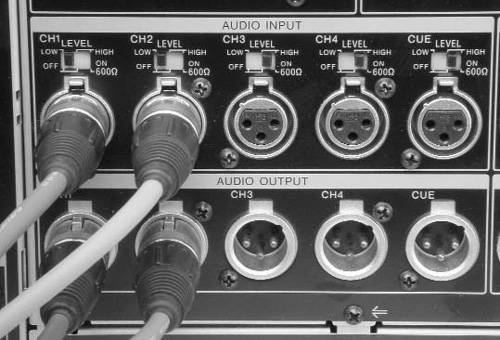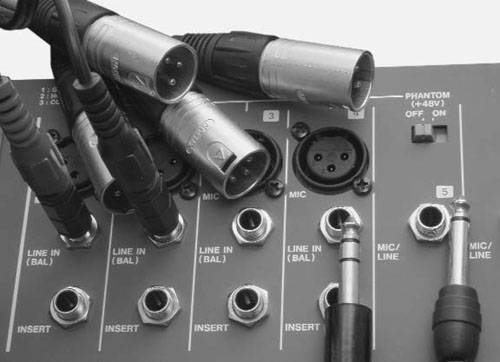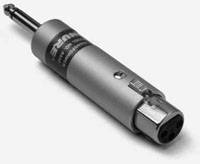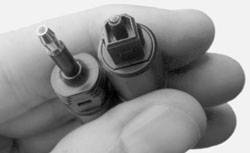Audio Interfaces
| Compared to video, audio comes in a bewildering variety of signal types, levels, and connectors. With video, it's pretty clear how to connect things, and you'll see right away when you've made a mistake, but audio is more complex. Often, two bits of equipment won't have the same types of connectors, and seemingly simple connections may be plagued with hums, buzzes, noise, or distortion. To the uninitiated, such problems appear random and their solutions arbitrary, but once you understand the different signal types and the connectors they use, you can patch together equipment with ease and troubleshoot audio problems with assurance. Analog AudioAnalog audio comes in two flavors: line-level and mic-level. Line level is further subdivided into high-level, "professional" audio and low-level, "consumer" audio.
Line LevelHigh-level pro audio has a nominal level of +4 dBm (+4 decibels compared to a standard reference of a signal dissipating 1 milliwatt across 600 ohms) and is usually carried on balanced cables with XLR connectors, although some systems use ¼-inch phone plugs. More Info For a description of decibels, see www.sizes.com/units/decibel.htm or http://experts.about.com/q/1356/2442821.htm. Balanced lines use three conductors: two conductors for the signal and one for a separate shield. The signal conductors are twisted together to reduce pickup of interference and noise and connect inside equipment in such a way that any noise common to both lines cancels itself out. Two-conductor plugs carry unbalanced signals. Three-conductor plugs carry balanced signals (or two channels of unbalanced audio and a common ground, as with headphone plugs and stereo minijacks). ¼-inch phone plugs and 1/8-inch miniplugs come in both flavors: two conductors, called tip and sleeve, and three conductors called tip, ring, and sleeve. XLR connectors are solid and robust; they lock firmly in place and provide clean and noise-free connections. You'll find XLRs (also called Cannon connectors) on most pro audio and pro video equipment. ¼-inch phone plugs are more common on musical instruments, sound reinforcement gear, and audio mixers oriented towards musicians or where space is at a premium. If a piece of gear has a "line" connector with an XLR or phone plug, it's almost always a high-level, +4 dBm connection, although sometimes it may be switchable to low-level. The XLR inputs on this Digital Betacam deck allow selection of high or low levels as well as 600-ohm termination for audio sources that need it.  Low-level audio has its nominal level at 10 dBm and normally travels on unbalanced, two-conductor cables with RCA plugs. RCA plugs and sockets may be color coded, with red for right channel audio and white (or black) for left channel audio. Most consumer audio and video gear uses low-level audio connections. Sometimes, mostly on compact consumer camcorders, audio will be bundled with video in a multi-pin miniplug connector as discussed earlier. Mic LevelMicrophone audio has a nominal level of around 50 dBm, give or take a few decibels. Mic connections can appear as XLRs on professional gear, ¼-inch phone plugs on musical equipment, or 1/8-inch miniplugs on consumer gear. In the latter case, the connection is often for a stereo mic; the plug has three conductors instead of the two used for a monophonic mic. (You can get mono-to-stereo adapters to plug a mono mic into a stereo jack and get the same signal on both channels.)  Some inputs on professional camcorders and recorders let you switch an XLR input between mic level and line level. HeadphonesYou'll also encounter headphone outputs on phone plug and miniplug connections. These may be two-conductor, monophonic signals, but usually they're stereo with three conductors. Their nominal levels are variable, but are usually close to the 10 dBm line level; in a pinch, you can use a headphone output as a substitute for a low-level line output, but be warned that the quality of headphones outputs is usually much lower than the quality of line outputs. Interfacing Analog AudioIf you have inputs and outputs of the same type, just connect them up, but if they differ, things get more complex. You can sometimes connect low-level outputs to high-level inputs and vice versa by carefully adjusting input and output levels, but the basic 14 dB difference in the standards means that you're likely to run into problems. Low into high is the safer combination; if you turn the input gain control up, you can often get a sufficiently strong signal to work with, but you may well add more noise from the excessive amplification of the strong signal. Level-matching amplifiers, available from audio and video supply houses, can provide clean interfaces between consumer and professional levels. Going the other wayhigh into lowis problematic because the high level of the incoming audio may exceed the capability of the low-level input circuits to follow the signal: you'll get clipping and distortion, even with the input gain turned way down. At the very least, you should use a pad or attenuator, a small inline adapter that cuts down the strong signal to an appropriate level for the low-level input. (Sometimes these are referred to as baluns, because they also adapt from the balanced line of the professional side to the unbalanced line of the consumer side, though many baluns simply convert between balanced and unbalanced without changing levels.) Level-matching amplifiers are available for this task, too; often you'll find boxes that incorporate high-to-low and low-to-high matching amplifiers in the same package, side by side. Putting a line-level signal, whether low or high, into a mic input is almost certain to cause overloads and distortions. Again, there are pads and attenuators for this purpose, including some built into patch cables. Tip Your local consumer electronics store often carries adapter cables designed to connect a stereo's line-level signal into a portable recorder's mic input. These cables normally have RCAs on the line-level side and miniplugs on the mic side. They're quite handy for feeding line-level signals into mic inputs when you have no better solution. Some audio mixers have mic-level outputs for feeding portable recorders or cameras. You can boost these to line level using a mic-to-line amplifier, or the mixer itself may have a switch or menu selection to boost the outputs to line level. Plugging a mic-level output directly into a line-level input usually gives you a good approximation of silence; there isn't enough of a signal to even tempt you to run this connection without a proper adapter. Digital Audio
Digital audio commonly moves around the studio as AES/EBU (Audio Engineering Society / European Broadcast Union) stereo pairs, two channels of 48 kHz audio combined into one signal. AES/EBU audio travels on 75-ohm unbalanced cables with BNC connectors, or 100-ohm balanced cables with XLR connectors. There are matching transformers or baluns available to convert between the two different signals. AES/EBU audio may also be embedded in an SDI video signal. Many of the SDI capture cards for FCP support embedded audio; some don't even support separate audio. There are embedder/disembedder products available to break the audio out into its own signals, or to combine audio and video, depending on the needs of the equipment you're connecting together. FireWire also carries digital audio, in combination with video or by itself using FireWire audio interfaces from MOTU, Roland/Edirol, TASCAM, MAudio, and others. These FireWire audio interfaces provide multiple channels (eight or more) of connectivity, terminating in analog and digital I/O ports. These are rapidly becoming the preferred way to handle multichannel audio on the Mac. You may also encounter S/PDIF (Sony/Philips Digital Interface) audio connections on RCAs, miniplugs, or TOSlink optical connectors, like the ones on the back of the G5. S/PDIF carries stereo or 5.1 (five channel plus subwoofer) audio. Aside from DAT (Digital Audio Tape) recorders, it's mostly used for high-quality home theater sound. As you might guess, there are converters to go between AES/EBU and S/PDIF interfaces, although they tend to be hard to findtry audio and musician supply houses. | ||||||||||||||||||||||||||||||
EAN: N/A
Pages: 205


